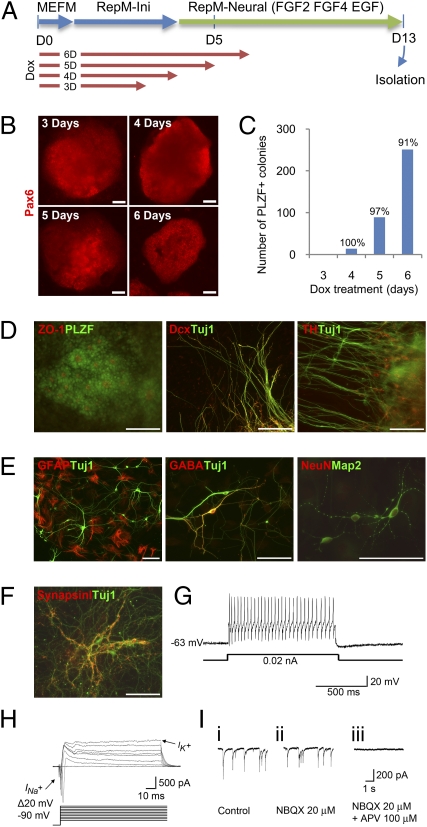Fig. 1.
Transdifferentiation by transient expression of the conventional four reprogramming factors generates functional neural stem/progenitor cells. (A) Scheme for the transdifferentiation of dox-inducible secondary MEF cells into neural stem/progenitor cells (NPCs). Duration of dox (4 μg/mL) treatment is for the indicated number of days. Different media were added sequentially as described in Materials and Methods. (B) Pax6 immunostaining on day 13 of colonies arising from the indicated durations of dox treatment; 8 μg/mL dox was used for the 3-d treatment. (C) Number of PLZF-expressing colonies generated with different durations of dox treatment, as analyzed on day 13. Percentages of PLZF+ colonies over total colonies are shown. (D) Immunostaining of colonies on day 13 with various neural or neuronal markers. (E) Immunostaining of spontaneously differentiated cells from isolated colonies on day 13 with various mature neuronal or glial markers. Long-term differentiated neurons showed characteristic synapsin I expression patterns (F) and generated a full train of action potentials during injection of 20 pA current (whole-cell configuration in the current-clamp mode) (G) as well as fast Na+ currents and outward K+ currents (whole-cell configuration in the voltage-clamp mode) (H). Mature neurons also showed glutamate-mediated excitatory postsynaptic currents (EPSCs, I, i), indicating synapse formation between neurons. EPSC amplitude was partially blocked by the AMPA-type receptor antagonist NBQX (I, ii), and the remaining component was completely abrogated by the NMDA-type receptor antagonist APV (I, iii) (whole-cell configuration in the voltage-clamp mode). (Scale bars, 100 μm.)

